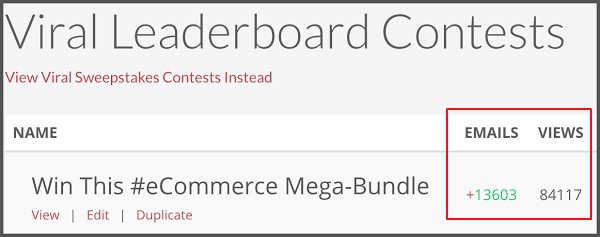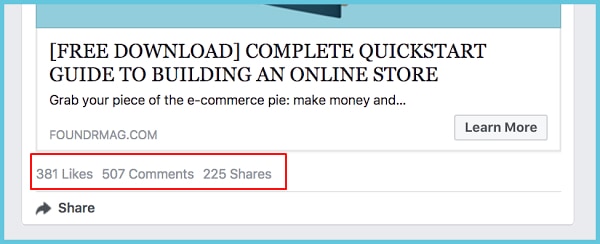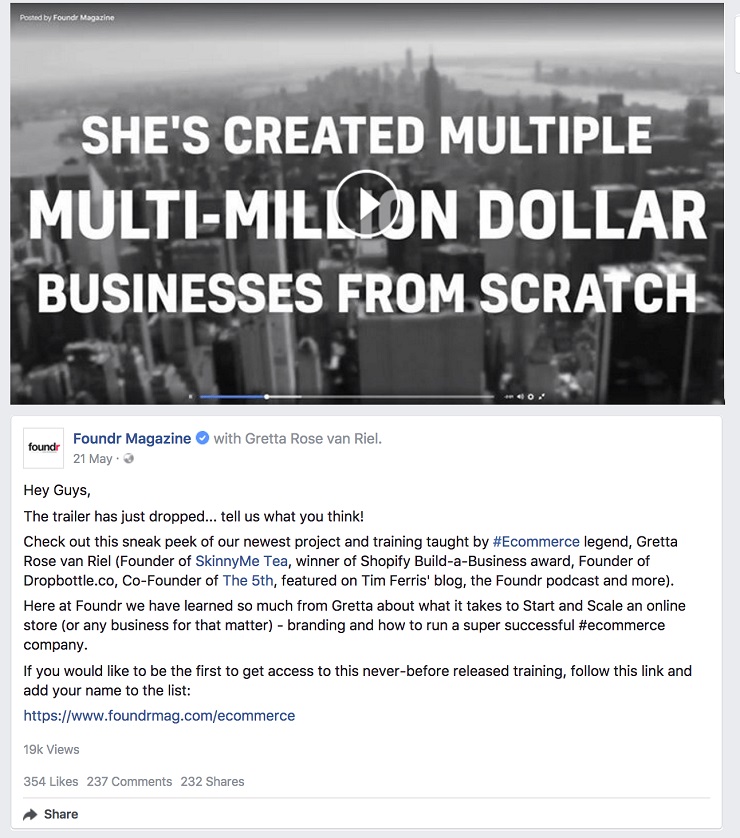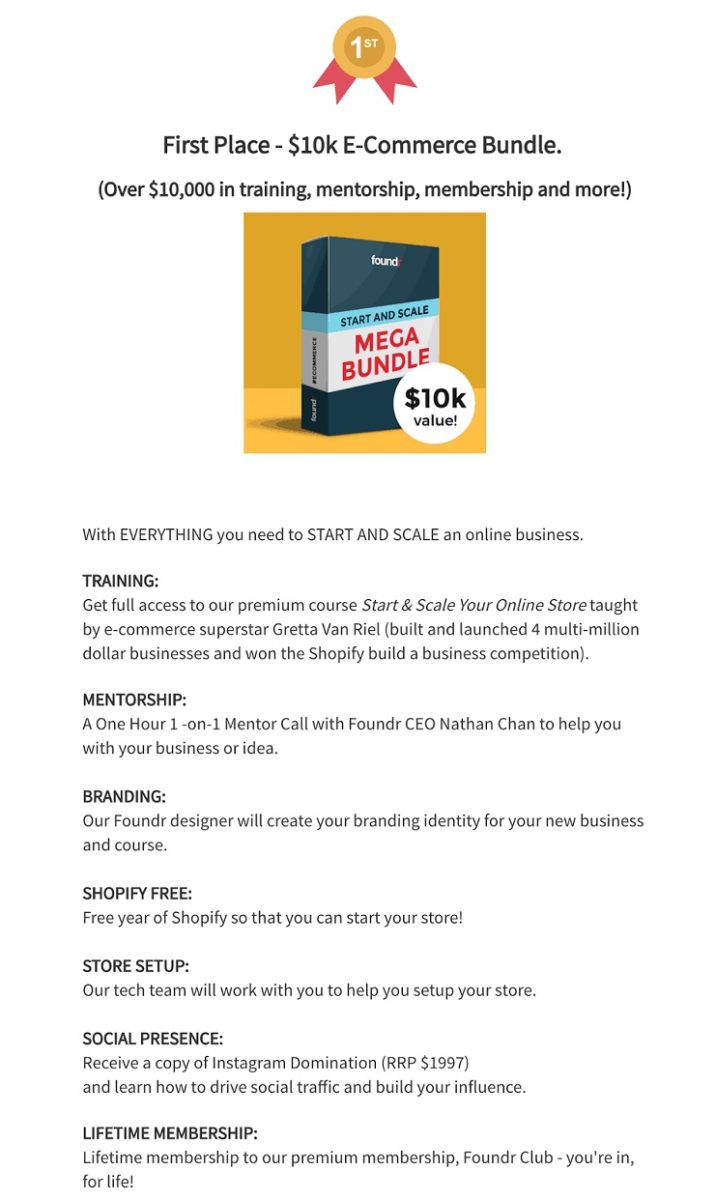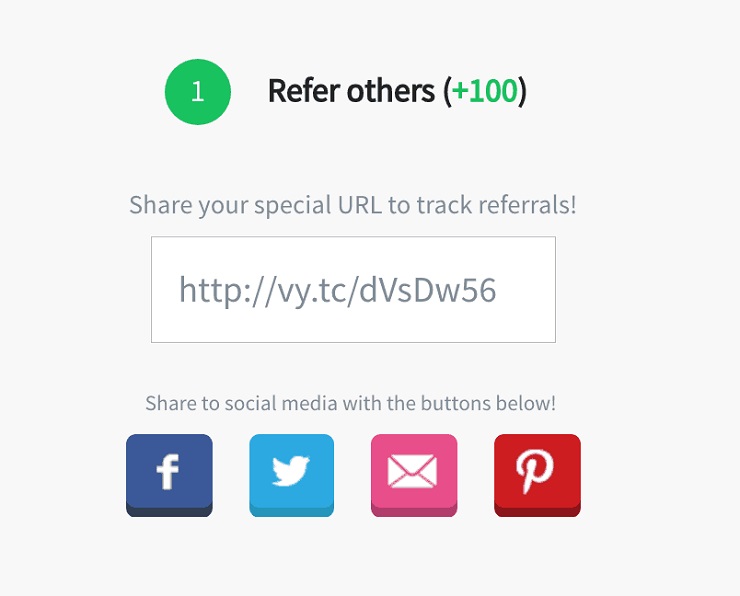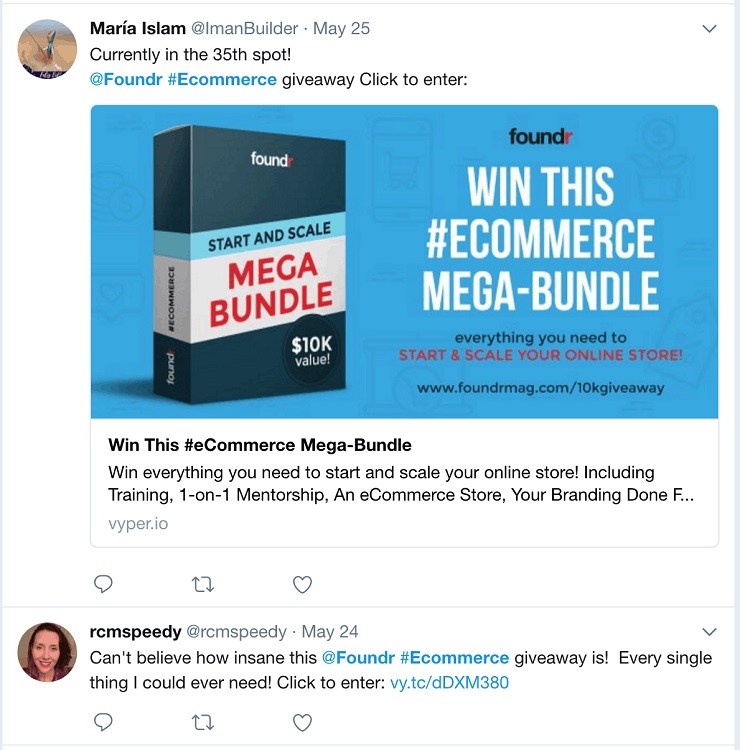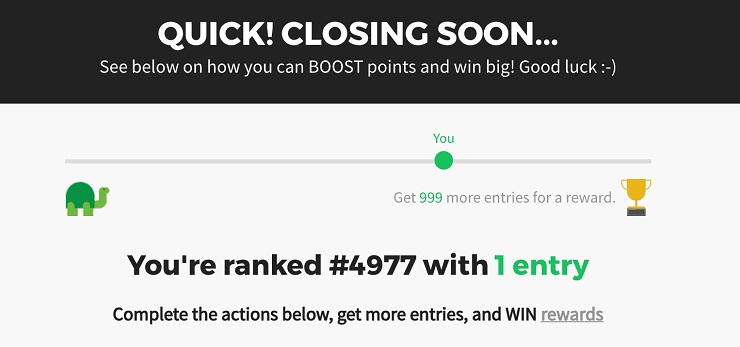I’ve been to the promised land and come back to show you the way, with an in-depth, behind-the scenes post showing you exactly how we grew our email list by 13,603 subscribers in 10 days. I’ll show you exactly what strategy and tools we used to get email signups, and who helped us pull off this quick win.
And more importantly … how you can apply these strategies and tactics to boost your own business and get a bunch of new fans and customers.
Our motivation behind landing this boost in growth was the launch of a new, somewhat niche product we had put together and wanted to promote. And while our number one goal was to get more email signups, the strategy we used led to an overall surge in attention across different channels.
Check out these results during the competition:
13,603 New e-mail signups & 84,117 pageviews (FB Pixeled)
19k Facebook views and 232 shares of our promotional video:
507 comments on a paid Facebook ad:
544 Blog Comments:
We also ended up with an additional 1,000 YouTube subscribers and a big boost in shares across all of our social media channels – including a few lesser used ones like Pinterest.
So, want to know how we got more email signups whilst running a full scale product launch?
Of course you do.
Let’s roll.
Explode Your Email List and Build High-Converting Landing Pages. Check Out Our List-Building Bundle!
The Challenge
We were three weeks away from launching a new Foundr training course, and as our head of product and business development, my team and I needed to create some anticipation, interest, and yes, some new email signups. Preferably a crap-ton.
We had just partnered up with Gretta van Riel of ecommerce and influencer fame to create an in-depth training on running a business with physical products, “How to Start & Scale Your Online Store.” As big as the ecommerce field is, this training is a relatively niche product,
because it assists students looking to start and build businesses from scratch with their own new physical products.
That takes some commitment and a little bit of spare cash, and it’s not for everyone. So I needed to find more of the right kind of people who would be interested in the training, tell them about it, and get them educated enough to understand that the course was worth at least 10x what we were charging.
We had seen the course and Gretta’s results. The training was gold, now I just needed to get some of the single most valuable commodity on the internet.
Attention
My goal was to get (at least) another 10,000 email signups to our email interest list for the course before we launched in just 21 days time, and as many views of our course trailer video as possible. We’d dropped a bit of cash on a fancy looking trailer, so we wanted to make sure that it was getting watched and shared.
How were we going to do that in such a short time?
We have a lot of followers on social media and who read the blog and are on our list, but we needed some new people, particularly those who would be potential customers for this product.
Fortunately, we had just spent a few weeks hanging out with Gretta, who is a total master when it comes to attention and ecommerce, and picked up some of her wisdom along the way. One particular tactic of hers that she uses to scale and accelerate the growth of her ecommerce stores stood out to me.
Competitions
Now if you’re anything like me, the idea of running an online competition sounded tacky and gaudy, with visions of flashing “free ipad” popups and the like.
But I had learned from Gretta that when a competition is done well, it can be a massive value add for the audience—a fun, exciting, and a powerful way to rapidly grow your following and still be on brand and classy (as classy as Foundr gets, that is).
Foundr CEO Nathan and I had a quick session with the whiteboard and decided a competition was the way to go. We laid out the following goals, which we felt were challenging but achievable.
- 10,000 email signups
- Maximize views and sharing of our video
- Increase referrals and resulting new signups
We also needed to finish the competition about a week before the course was going to be launched so we could get new email signups into the pre-launch sequence to find out more about the training and decide if it was right for them. That shrunk our window down to just ten or so days.
Explode Your Email List and Build High-Converting Landing Pages. Check Out Our List-Building Bundle!
Key Elements of a Competition
Next we hashed out how could we achieve this with a competition and considered the following options:
- What could we give away? What could we give away that would incentivize email signups and add potential buyers to our list, without spending cash? We’d already spent our marketing budget on creating extremely high-quality studio filming for the course.
- Which tool should we use? What SaaS tool should we use to run the competition?
- How could we maximize sharing and referrals? How could we get people to not only sign up, but also spread news of the competition and the online course?
#1 Deciding What to Give Away
Since a major goal of our competition was to generate interest and leads for the new ecommerce course, it was important that the email signups and leads were relevant.
We were firm that the grand prize needed to be something highly desirable for the target audience of the course.
That way, the chances that participants who didn’t win would go on to purchase the training would be much higher. They would also be higher quality leads, i.e., someone who was signing up out of interest in ecommerce and Foundr, not just a rando who wanted to win free stuff.
The first key factor was linking the prize to our product and our target audience’s desire. And naturally, our second factor was cost. What could we give away that had value, but low fixed or hard costs?
Here’s what we came up with:
First prize was the course and everything you could need to succeed with ecommerce, starting with our newest training, How To Start & Scale Your Online Store.
We spoke to our friends at Shopify to see if they could get behind us, which they did, and lined up Nathan Chan (our CEO) to give a Skype mentoring call, and our awesome graphic designer Giuliano to give branding support.
To increase the value, we bundled in a lifetime membership to our private entrepreneurs club and Instagram training as well. Both immensely valuable, but there was no additional cash needed from us.
The extras were also in line with ecommerce—if you wanted to get into ecommerce in a big way, winning first prize would be a godsend.
Fixed costs to us: $0.
We also added in a leaderboard, but more on that later.
#2 Deciding which tool to use
Given quite a few people have written about the strength of competitions to rapidly grow a following and email list, a number of SaaS and software tools have popped up over the past few years that you can choose from.
Each has its own pros and cons depending on your goals and your marketing stack.
We wanted a competition software that had the following features:
- Referral-based: Something that would enable people to refer their friends and create a viral element
- Had a Leaderboard: They look cool and make people more competitive
- Integrations: Could ideally talk to Infusionsoft
- Idiot-proof: Didn’t require coding so that I could get it up and running quickly on my own
- Incentivized: Would reward people for for each and every share on social with tracking of referrals
- Fun: Something that our audience would enjoy.
Some options were:
Vyper had sweet-looking leaderboards and the CEO Jack had recently emailed Nathan to ask if he wanted any help with competitions.
This was such a simple, smart business development move by Jack. His email meant that Vyper was top-of-mind, met most of our needs, and we knew we could most likely chat with Jack and get things moving.
The only thing at the time it couldn’t do was easily integrate with Infusionsoft. We had a workaround (export to .csv and upload to infuso), and it was otherwise what we were looking for, so all good. Naturally, we still did some research on other competition software to see if we were making the best decision.
But please note, at Foundr, we move fast.
I didn’t have time for extensive research, so Nate and I jumped on Google, opened five tabs, read the features, tested things out, and made a decision on the spot within about ten minutes.
That’s to say, I’m sure that there are plenty of other competition tools that either I hadn’t heard of, or have been developed since the time of writing this. In fact, if you know of any good ones that you can recommend (and you aren’t just spamming links), please let me know in the comments below.
But for us, Vyper was the tool for the job. Even better, I got in touch with Jack (who turns out was a fellow Aussie), who gave me some insider tips on how to run a successful competition.
A large part of the reason our strategy succeeded was from following a lot of Jack’s advice. He had some clever ideas to maximise each part of the competition. Since I was in go-mode, I just did my best to follow his advice and GSD. So sure, I’m a genius, but what I did well was to listen to the expert and do my best to execute on his advice.
Some of this is hard to explain (and since the competition has now ended the page is no longer live) so instead, here’s a quick walkthrough of the signup process.
Steps Involved in Setup
If you want to run a competition, it’s important that you factor these steps into your project plan.
Graphics: You’ll need great graphics that people can share and use to refer others. We used our own designer, but if you are running lean you could do it on Canva. Be sure to allow time for this. You’ll want a shareable image correctly sized for each social media channel.
Basic Setup: Setting up the competition (title, name, dates and other basic info rules, etc.)
Pages: Creating the competition page (this is the most time-intensive aspect, it’s basically a landing page using a WYSIWYG editor with basic html) and a “thank you” page.
Actions: Deciding on different actions and incentives for users to take to increase their competition points and chances of winning, e.g. comment on a blog post, etc.
Add Facebook Tracking Pixel: If you know about FB ads, then you’ll know about retargeting, and you want to be pixeling people who visit. Make sure you pixel visitors for later on.
Emails: You’ll need to create an opt-in/follow-up email as well as any emails when entrants hit certain milestones or points, to keep them engaged and incentivized. As a minimum I recommend you write 1 x “thank you for entering” e-mail.
To increase the gamification of the competition you can also trigger e-mails to be sent when entrants achieve or unlock certain aspects.
Here’s the email we sent when somebody signed up to enter the competition:
You’ll notice that it rewarded them for taking action and then motivated them to take more actions and encouraged them to get competitive and check the leaderboard.
#3 Maximizing Sharing and Referrals
A key part of any viral competition is to encourage and land referrals. That is, get people to get their friends to sign up to your competition and reward them for doing it.
Vyper and most competition tools allow you to do this by creating special referral URLs for each entrant that they can share with their friends, which is then tracked to figure out how many friends they are sending to the competition.
You want to make it as easy as possible for your subscribers to spread the word about your competition, and that means getting them to share it across social media.
This is what users saw on our thank you page:
The options are to either manually copy and paste their unique url, or to click on the social media icons that generated pre-populated messages and shareables.
For example, this is what it looked like when Maria shared her link on Twitter:
Explode Your Email List and Build High-Converting Landing Pages. Check Out Our List-Building Bundle!
Leaderboards increase sharing
This was really where Vyper had a lot of built-in and ready to go tools that we wanted.
We decided on a “leaderboard” competition, because this created a visual scoreboard for everyone who had entered.
Why do leaderboards work?
Well they just do. But since that’s not a great answer I found this one instead from Steve Sims of Behavior Labs.
“Competition is a hardwired part of human nature.
It is one of the greatest forces that motivate people to perform better, work harder, and strive to reach their goals…
When multiple people are competing, those who are highly self-motivated by internal goals and aspirations are typically found in first place – at the top of the leaderboard. Those in the top spot need a degree of self-motivation since they are already besting their competitors.
Those in second, third, fourth and even last place have a different kind of motivation.
The competitive psychology that drives the need to evaluate ourselves and compare our own performance with those around us kicks in for those further down on the leaderboard, and it can be fueled by a variety of factors, including situational dynamics, rivalries, time and even fear…
Leaderboards are an excellent way to leverage competitive drive, gain insights into user behavior and keep engagement levels at their peak.”
Basically, we are competitive and wired to win. A leaderboard engages our ego and desire to beat others. Even just the other day I got suckered into a competition when I found out I was in 16th place. Damnit, I wanted to win so put in a few extra tweets to see if I could climb up the ladder overnight.
Using Gamification To Increase Our Followers:
To increase their chances of winning, users were rewarded additional points for following us on our different social media channels.
Vyper tracked if they followed our different social media accounts and rewarded them an extra 25 points each time they did.
Here’s a screenshot:
The results?
We have pretty good growth on our social channels so it was a little hard to track, except on YouTube, which we hadn’t been promoting at all until this competition.
I checked some analytics on socialblade.com for our youtube account. Have a look what happened in May during the competition (an increase of about 1,000 subscribers):
Not bad.
Bonus Gamification Hacks
Jack told me that we could add in custom actions or milestones to further incentivize users to take specific actions.
Like what?
Well we chose a couple of “bonus” actions that we wanted users to take that would benefit us. The first was asking entrants to like, comment, and share a Facebook post. Jack taught me this pretty sweet little hack to bring your Facebook CPA down (which I hope he won’t hate me for sharing here).
Basically, you set up a Facebook advertisement/promoted post as a “dark post” so that only users with a direct link will see it. Then by encouraging users to engage with the ad, Facebook sees the post getting good engagement, thinks it must be a great ad, which then helps you to lower the cost of displaying that ad. Hope that makes sense, if not, you’ll need to tell your FB ads team or study up. It’s not covered in the scope of this article.
Other bonus actions we rewarded were “comment on this blog post,” causing one of my blog posts to receive over 500 comments and make me look like a thought-leading rockstar. We also got people to sign up to our Facebook messenger bot so that we could use that as another marketing channel for the course too.
These customizable rewards were game-changers. They lowered the cost of our Facebook ads, boosted engagement on the blog, and got our users taking more and more actions.
This also helps to trigger an important behavioral response that I first learned from Robert Cialdini. He covers this at length in his excellent book, Influence: The Psychology of Persuasion (highly recommended). In short, research shows that if people commit to an idea or goal, they are more likely to honor that commitment and see it through to completion. And the more actions you can encourage someone to take, the more likely they will be engaged in the process.
This means that they will be more likely to keep participating in the competition, because they have already signed up, shared it with their friends, and so on. At a basic level, it’s relationship building and engagement. There are more touch points and to keep things fun and fair, more rewards.
We always try to give far more value than we get. So yes, I was asking people to do things for me, but with the built in gamification, they were rewarded with more points and prizes along the way.
Kickstarting the Competition
Finally, when everything was ready to go, we posted about the competition on social media and Nathan ran an Instagram LIVE as well. The obvious issue for us was that even though we have a pretty solid email database and social media following, they are largely already on our email list. So we needed to get additional reach. This is where the referral element was so strong. We could tap into our friends and followers, to tell their social circles about the competition for us.
Explode Your Email List and Build High-Converting Landing Pages. Check Out Our List-Building Bundle!
Conclusion
Competitions work well and will continue to work, especially if you use gamification and rewards for each level of participation. It’s hard to beat the level of desire that it builds for your product, because they have already committed to their desire for having your product. By competing to win your product, that desire is further increased. If they don’t win, the only way to satisfy that craving is to purchase it. And hey, along the way you can share your message, brand, have fun and give them some great content and rewards.
Action Steps
I’ll leave you with a few quick bullet points to consider when you put your own competition together:
- What can you give away? What can you give away that would incentivize email signups and add potential buyers to your list, without spending cash?
- What tool should you use? Decide which tool you want to use for your competition. Don’t spend too long here. Do some research, make a decision and keep moving.
- How can you maximize sharing and referrals? Is there anything else you can do to keep things moving and encourage? Perhaps offer some bonuses along the way such as a guide or ebook, offer milestones and different levels of prizes.
Resources & Links
Recommended Reading
Influence: The Psychology of Persuasion, by Robert Cialdini
Using Competitive Psychology and Leaderboard Alternatives to Drive Engagement
Finally, after getting all those comments on my last blog post, I’m now addicted to it, so I’d love to hear from you. It helps my ego, and in return I’d like to help you.
Do you have any questions about running a competition? Ask in the comments below, and if I can’t answer, I am sure that another Foundr member or internet random will be able to help you.
In the spirit of competition, the best comment (as voted by the Foundr team based on which comment generates the most engagement) on this post by the 10th of August 2017 will receive a free copy of our new Foundr V1.0 book.
Winner will be announced in the comments section below on the 11th of August.
***Editor’s Note: this competition has ended.

